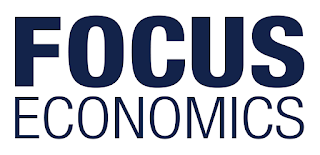The economy shrank at the sharpest pace since the global financial crisis in Q1, weighed on by lower consumption, investment and exports amid social distancing restrictions. The downturn in Q2 will be significantly steeper as the full impact of the national lockdown is felt. In April, retail sales plummeted at a record rate, employment and wages fell, and jobless claims increased roughly 70% to over 2 million. However, the economy now appears to have bottomed out, as both the manufacturing and services PMIs picked up somewhat in May, despite languishing deep in contractionary territory. Moreover, the extension of the wage subsidy scheme through October will prevent a more marked rise in unemployment, while the gradual easing of lockdown measures—non- essential stores are set to reopen in England from 15 June for instance— should support a recovery in domestic economic activity.
The economy will shrink markedly this year due to the impact of Covid-19 on private consumption, investment and exports, notwithstanding huge fiscal and monetary stimulus. A possible second wave of infections as the lockdown is lifted is a key risk to the outlook, while uncertainty over Brexit talks further clouds prospects.
The pound traded at USD 1.23 per GBP on 29 May, depreciating 1.0% month-on-month due to a decline in government bond yields and Brexit fears. Looking ahead, our panelists see the pound strengthening somewhat by year-end, although possible further monetary easing and a lack of clarity over Brexit negotiations could see downward pressure resume. Our panelists project the pound to end 2020 at USD 1.27 per GBP and 2021 at USD 1.33 per GBP.
GDP decreased 2.0% in the first quarter (Q4: 0.0% seasonally-adjusted quarter-on-quarter), marking the worst reading since Q4 2008. Private consumption contracted 1.7% in Q1 (Q4: -0.1% s.a. qoq), weighed on by social distancing measures and weak consumer sentiment. Public consumption fell 2.6% (Q4: +1.5% s.a. qoq) on lower non coronavirus-related health spending, and school closures reducing spending on education.
Meanwhile, fixed investment contracted 1.0% (Q4: -1.2% s.a. qoq) amid shrinking housing and public investment. Exports of goods and services fell 10.8% in the first quarter, which contrasted the fourth quarter’s 5.0% expansion, due to lockdowns around the world. Imports of goods and services dropped 5.3% (Q4: +0.4% s.a. qoq). As a result, the external sector subtracted 1.9 percentage points from growth, contrasting the 1.5 percentage-point contribution in Q4. On an annual basis, the economy contracted 1.6% in Q1, contrasting Q4’s 1.1% increase.
The economy is seen declining far more sharply in Q2 as the full impact of the nationwide lockdown declared in late March is felt. Looking further ahead, panelists see activity recovering somewhat in H2 as restrictions are lifted in the UK and around the world; however, the possibility of a second wave of infections—and subsequent reinstatement of lockdown measures—is a key risk.
James Smith, economist at ING, comments:
“The period between April and June will see a much steeper decline. It’s now very hard to imagine a rapid ‘V-shape’ recovery, and we don’t expect a return to pre-virus levels of activity until 2022 at the earliest.”
FocusEconomics panelists expect the economy to contract 7.6% in 2020, which is down 1.5 percentage points from last month’s forecast, and to expand 5.9% in 2021.
Industrial production dropped 4.2% month-on-month in seasonally-adjusted terms in March (February: -0.1% mom). March’s figure marked the worst reading on record. The weakening was driven by a sharp fall in manufacturing output. In addition, electricity, gas, steam and air conditioning supply output weakened. On an annual basis, industrial production fell at a more pronounced rate of 8.2% in March (February: -3.4% yoy). The reading marked the worst result since August 2009.
Meanwhile, the trend pointed down, with the annual average variation of industrial production coming in at minus 2.7% in March, down from February’s minus 2.0%. FocusEconomics Consensus Forecast panelists project that industrial production will decrease 8.4% in 2020, which is up 0.1 percentage points from last month’s forecast, and increase 5.7% in 2021.


